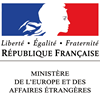One of the most beautiful Palaces in Paris

Hôtel de la Rochefoucauld Doudeauville, residence of the Italian Embassy
Welcomed by H.E. Ambassador Emmanuela d’Alessandro, we were able to discover the sumptuous Hôtel particulier which houses the Italian Embassy.
This palace was built in the 17th century for a rich banker, secretary to the King.
Over the centuries, important works were undertaken, in the 19th century in particular, by one of the most renowned architects of his time, Henri Parent.
A majestic grand staircase in polychrome marble was inspired by the Queen’s staircase in Versailles. The marble panels set three tapestries of the Goblins which had been offered by Louis XV to the Emperor of China. After the sacking of the Summer Palace, they were bought back for this palace which bears the name of two successive owners, Hôtel de Boisgelin and, under the Empire, Hôtel de la Rochefoucauld Doudeauville.
A first salon, called the "Salon de la mappemonde" because of a magnificent 16th century Italian globe, opens onto the "Grand salon" which is the only one to have entirely kept its original décor.
A two-way mirror over the fireplace allows a view of the adjoining salon. The panelling comes from the royal castle of Bercy, which was demolished after the revolution and whose contents were sold for several days.
Another salon is typical of both Italian and French taste in the 18th century, the "chinoiseries". Panels depicting imaginary scenes of life in China, executed by Piedmontese craftsmen.
The beauty and refinement of this palace blossoms from salon to salon and we discover the "teatrino siciliano" of the 18th century Palazzo Butera in Palermo, transported to Paris by its former owner on the occasion of his marriage to a descendant of the Maréchal d’empire Michel Ney.
Everywhere birds, flowers, all sorts of characters from the Commedia dell Arte and under the carved wooden archway, Lovers are flying in the air. The ceiling is decorated with flowers and leaves in sheet metal imitating those of the old Hospital of Palermo.
The 20th century is also represented in the garden. It houses a work by a famous contemporary artist who has exhibited at the Louvre, Michelangelo Pistoletto: "The Third Paradise".
Have we not caught a glimpse of it?
This palace, following an agreement between France and Italy in 1937, was given to the Italian government on a long lease and became the seat of the Italian Embassy. In return, the superb Palazzo Farnese is the headquarters of the French Embassy in Rome.

By Nicole Tordjman
© Wikimedia Commons


